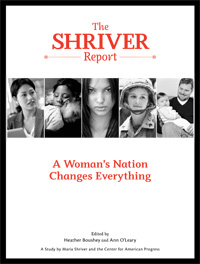Women now comprise half of all American workers, and women are either the primary or co-breadwinners for two thirds of all American families. Maria Shiver, in conjunction with the Center for American Progress, published a fascinating new report last month that outlines the ways that having a large female workforce is changing the landscape of American business, family, and health status. The entire 400 page report can be downloaded by chapter, or read online here.

Image: americanprogress.com

Of primary interest to the readers of this blog is the chapter about the health of the working woman entitled, "Sick and Tired: Working Women and their Health" by Jessica Arons and Dorothy Roberts. A few really interesting points that I'd like to pull out:
- A quarter of women still receive insurance through their husband's employers. This means if something happens to her husband, or a couple decides to divorce, a woman could very quickly lose her coverage.
- There currently seems to be a two-tier system in the business place with regards to breastfeeding: professional mothers are accommodated, while working-class mothers are not.
- Women are often exposed to chemicals that can impair fertility while in the workplace. Alternatively they are excluded from certain male-dominated fields because of concerns over these chemical impacts, rather than just making these workplaces safer.
- The act of being a caregiver, which is usually done by women, can have health impacts: caregivers are more likely to report having heart disease, cancer, diabetes, and arthritis. The chronic stress felt causes women to also be more likely to suffer from stress-induced headaches, sleeplessness, irritability, and depression.
- Women are more likely than men to work in jobs that are low-wage, part-time, or for small businesses; all are positions that infrequently offer employer-based insurance.
- The practice of "gender rating," or charging women more than men for insurance premiums, is common among private insurers. They are also more likely to deny coverage or increase premiums for women based on preexisting conditions that only or disproportionately affect women.
- Because they have to pay more for insurance, and make less than men, women spend a higher percentage of their income on healthcare. They are more likely to be forced into medical bankruptcy when things go wrong.
The article has a lot of good personal stories to illustrate some of the hardships encountered with healthcare for working women, and really touches on the ways that race and economic status can put certain women at even more of a disadvantage. The chapter is such a great look at the ways that we, as working women, are impacted differently by the types of jobs we have, the influences of these jobs (and our non-paying jobs as caregivers) on our health, and the ways we are able to afford our healthcare. I highly recommend checking it out; it can be directly downloaded here.

Comments